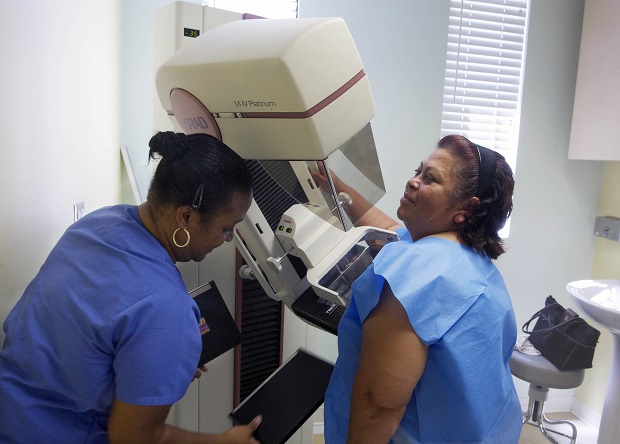Personalized breast cancer treatment has saved millions—experts

In this May 6, 2010 file photo, detection lead mammographer, Toborcia Bedgood, left, prepares a screen-film mammography test for patient Alicia Maldonado, at The Elizabeth Center for Cancer Detection in Los Angeles. A new, international panel of experts has studied the most recent evidence on mammograms to screen for breast cancer and says they do the most good for women in their 50s and 60s. Women 70 to 74 also benefit to a lesser extent. But evidence that screening helps women in their 40s is “limited,” the panel said, although some members disagreed this was true for women 45 to 49. AP Photo
PARIS, France—In just three decades, the once monolithic approach to diagnosing and treating breast cancer has become more personalized and less intrusive—a transformation that likely saved millions of lives, experts say.
From testing methods adapted to an individual’s level of risk, better drugs and selective use of chemotherapy, treatment is no longer a one-size-fits-all for some 1.6 million people diagnosed with the disease every year.
“In the past few decades, we have witnessed major changes and improvements in the treatment of breast cancer,” Justin Stebbing, a professor in cancer medicine at Imperial College London, told AFP.
Despite advances, breast cancer remains the leading cancer killer of women aged 20 to 59 worldwide. Every year the disease claims more than half a million lives, according to the World Health Organization.
Taking a bite out of this grim toll through better awareness is the goal of October’s Breast Cancer Awareness Month, which will see the Eiffel Tower glow pink, and a fashion show in London starring cancer survivors.
Much has changed since the 1980s, when mastectomy—or surgical removal of the breast—was the go-to treatment for all types of breast cancer.
Today’s approach prefers to target just the tumor, called a lumpectomy.
Not only are better drugs available, but doctors also have a much better understanding of disease variations between patients, requiring different therapies.
The hormone treatment Tamoxifen, for example, effective against 70 percent of breast cancers, has become key in treating pre-menopausal women since trials in the 1980s.
At the same time, an alternative called Anastrozole is effective in women who have already gone through menopause, said Aine McCarthy, a doctor and spokeswoman for charity group Cancer Research UK.
‘Into the millions’
Research in recent years has questioned the central role of chemotherapy in cancer treatment, with a study this week in the New England Journal of Medicine saying some women in the early stages of the disease may not need it.
“In some low-risk patients we know that (chemotherapy) is of no use; in others, it is indispensible,” said Roman Rouzier, a cancer expert at the Institut Curie research center in Paris.
While most developed nations recommend regular testing for women from about the age of 50, some advise earlier examination for those with breast cancer in the family, or a gene mutation that raises their risk.
Carriers of the BRCA1 mutation have a lifetime risk of about 80 percent of developing breast cancer, compared to about 10 percent for women without it.
About 0.2 percent of women, or one in 500, carry a harmful mutation in the BRCA1 or the less dangerous BRCA2 gene (BRCA stands for BReast CAncer susceptibility).
The genetic flaw accounts for a small number of cancers overall, but has been found in half of families with multiple cases of breast cancer, and in up to 90 percent of those with both breast and ovarian cancer.
With today’s higher level of care, the five-year survival rate of people diagnosed with breast cancer now hovers at 80 percent in most Western nations, according to the WHO.
The percentage is half that in the poorest countries.
McCarthy said that if you figure survival rates have nearly doubled over the past 20 years, many who would have died in past decades have survived.
“We’re saving hundreds of thousands of lives per year,” she added. “That’s a lot of women’s lives that are being saved worldwide, we’d have to be up into the millions.”
RELATED STORIES
Blood test could predict breast cancer’s return—study
Breast cancer still the most common among women, says American Cancer Society